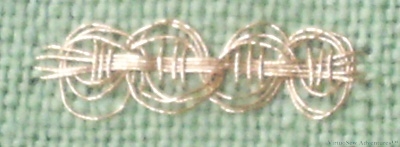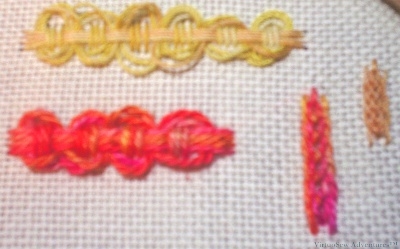Tudor and Stuart Goldwork – Month Five Stitches
As I’ve mentioned, while I continue to persevere with the silkwork (there is a limit to how long I can stitch such fine work, even with the magnifier), I’m practising the goldwork stitches on a separate cloth. I don’t want the silk catching on metal threads while I’m working it, so the best way to avoid the problem is to do no metal thread work until the silk is finished. However, I couldn’t bring myself to ignore all the interesting stitches we are promised – hence the practice cloth.
I can see potential to use the Reverse Chain with Buttonhole Edging in the Amarna panels, since it creates a very complex impression when seen at real size, while not being all that difficult to stitch. It looks a lot like a braid or a filagree, so might be used to represent the necklaces that the Pharaoh gave to favoured courtiers at the Window of Appearances.
Guilloche stitch was an entirely different matter. It didn’t seem to matter what I tried, I couldn’t keep the crossing places of the final stage neatly under the long straight stitches, and the loops wouldn’t stay neat. In fact I even had a go in cotton threads, as you can see below.
The yellow is a mercerised cotton, while the orange is a fairly heavy pearl cotton. The Guilloche stitch seemed to work better in the heavy pearl cotton, which makes me wonder whether it is simply a matter of scale. The bulk of the pearl cotton makes the stitch so much more compact, whereas the gold thread on the practice cloth is much too fine for the spacing of the stitches. Note that the Reverse Chain with Buttonhole Edging looks much more braid-like with the finer, mercerised thread, where the pearl cotton almost looks like a different stitch. All of these stitches should also be easier when I’m working on the real piece which is resting on a floor frame. I’ll be able to use both hands to control the thread if necessary!




Fabulous. I especially like that Guilloche stitch!
the gold thread looks so sumptuous against the mint coloured cloth and so far so good, very quiet and accident free here today!
For best practice for working samplers/embroidery in a frame, which I learnt at the RSN, you should always cover any areas of your fabric which are not being worked on, either with clean cloths or folded acid free tissue paper (at least a double layer) which are then pinned in place. If you are using a slate frame and rolling the fabric in to get to the centre, you should also place a cloth (clean muslin or sheeting) along the edge of the tape on the frame and roll it in so that the fabric you are working on does not a) contact the frame or b)contact itself. This should be long enough to cover the whole framed piece, or at least half of it, one from either side, for when you are not working on it it can cover the work and be pinned in place so it cannot be removed by accident.
When working on the piece only uncover the minimum amount of background fabric, making a small window of cloths/ paper to show the area you are working on. These should be pinned in place to stop them moving as you work and because they cover previously worked sections will stop you from snagging your working thread on them.
The downside is that you don’t see the whole piece all at once, but the upside is that it is kept as clean and undamaged as is possible and if you have prominant sections they are not rubbed excessively whilst working.
Hope this explaination makes sense and is of some help.
Posy
Wow, loving that guilloche stitch. Worth persevering with, I think (mind you, it’s you who’s doing it, not me!) I think it looks quite spectacular.
Great idea for the Pharaoh’s necklace!